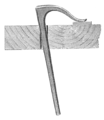Holdfast (tool)
 A holdfast being used to secure a workpiece to the workbench. | |
| Other names | Hold fast, hold-down |
|---|---|
| Used with | Woodworking workbench or anvil |
A holdfast or hold fast is a tool used to hold a workpiece firmly to the top or side of a wooden workbench or on the top of an anvil.[1]
A traditional holdfast is shaped with either a curved or flat top. In use, the shank fits loosely into a hole in the top or side of the bench or in the top of the anvil, and the tip of the hook is pressed against the work. The holdfast is set by hitting the top with a mallet or hammer, which causes the shaft to wedge against the sides of the hole. It is released again by hitting the back side.
Contemporary holdfasts are commonly designed to fit in 3⁄4 inch (19 mm) holes, but historically holdfasts with a larger diameter were more common.[2] In workbenches holdfasts typically have dedicated holes, but they can also be used in suitably sized round dog holes.[3] To avoid marking the workpiece, scrap pieces of wood or leather are often used between the face of the holdfast and the workpiece.
Types[]
Different types of holdfast include:
- Traditional holdfasts made as steel castings, or forgings, or modern holdfasts are made from round mild steel bar stock using highly automated cold-working machines. Tool suppliers market such holdfasts, made from cold-rolled bar stock which is slightly under 3⁄4 inch (19 mm) diameter, usually 23⁄32 inch (18 mm), for use in the now customary 3⁄4 inch (19 mm) bench holdfast holes. The are constructed with either a curved or flat top.[citation needed]
- Screwed holdfasts, sometimes called a hold-down. A later adaptation of the traditional holdfast. Rather than being knocked into place with a mallet or hammer it is tightened by turning a screwed handle.[4]
- Wooden holdfasts based on the traditional or screwed holdfast design, but made by a woodworker from, for example, timber and plywood.
- Wooden holdfasts carved from a forked tree branch. Sometimes called a barilette.[5]
History[]
Based on a fresco discovered in the ruins of Herculaneum, holdfasts are known to have been in use since at least the 1st century AD.[6] Holdfasts are also described and illustrated in early European books on woodworking, such as Joseph Moxon's 1678 edition of Mechanick Exercises and André Jacob Roubo's 1774 L'Art du Menuisier.[7][8] The term holdfast has been in use since at least the 16th Century.[9] The holdfast declined in use throughout the 20th century, but has seen a resurgence in recent years.[10]
Gallery[]

Illustration from L'Art du Menuisier (1769) demonstrating how the holdfast becomes secured in the workbench hole.

Roman workbench with a holdfast, based on a 1st Century AD fresco from the ruins of Herculaneum.

Illustration of a screwed holdfast from Cassell's Carpentry and Joinery (1907)

Illustration from L'Art du Menuisier (1769) showing a workbench with holdfasts in use.
See also[]
References[]
- ^ Bealer, Alex (1989). Old Ways of Working Wood: The Techniques and Tools of a Time-Honored Craft. New York: Bonanza Books. p. 73. ISBN 0-517-69313-5.
- ^ "Why a 1″ Holdfast Hole?". Lost Art Press. 2019-04-03. Retrieved 2020-09-10.
- ^ Schwarz, Christopher (2010). "Appendix Two: Other Bench Adventures". The Workbench Design Book: The Art and Philosophy of Building Better Benches. Cincinnati, Ohio: Popular Woodworking Books. ISBN 978-1-4403-1040-9. OCLC 656213165.
- ^ The Complete woodworker. Jones, Bernard E. (Bernard Edward), 1879-1965. (New ed.). Berkeley, Calif.: Ten Speed Press. 1980. pp. 50–52. ISBN 0-89815-022-1. OCLC 7283260.CS1 maint: others (link)
- ^ Schwarz, Christopher (2012-10-19). "The Holdfast in Your Backyard". Popular Woodworking Magazine. Retrieved 2020-09-10.
- ^ Schwarz, Christopher (2018). Ingenious Mechanicks: Early Workbenches & Workholding. Fort Mitchell, Kentucky: Lost Art Press LLC. pp. 4–8, 100–110. ISBN 978-0-9978702-7-5.
- ^ Moxon, Joseph (April 1678). "The Art of Joynery". Mechanick exercises, or, The doctrine of handy-works : began Jan. 1, 1677 and intended to be monthly continued. Boston Public Library. London: Joseph Moxon, at the sign of the Atlas on Ludgate Hill. pp. 56–61.
- ^ Roubo, M. André Jacob (1769). L'art du menuisier. Getty Research Institute. Paris: Académie Royale des Sciences. pp. 32–35.
- ^ "How do You Say 'Holdfast?'". Lost Art Press. 2014-03-02. Retrieved 2020-09-10.
- ^ "Holdfasts - How To Make Them Grip Like A Gorilla". The English Woodworker. 2013-05-28. Retrieved 2020-09-10.
- Woodworking clamps
- Tool stubs



